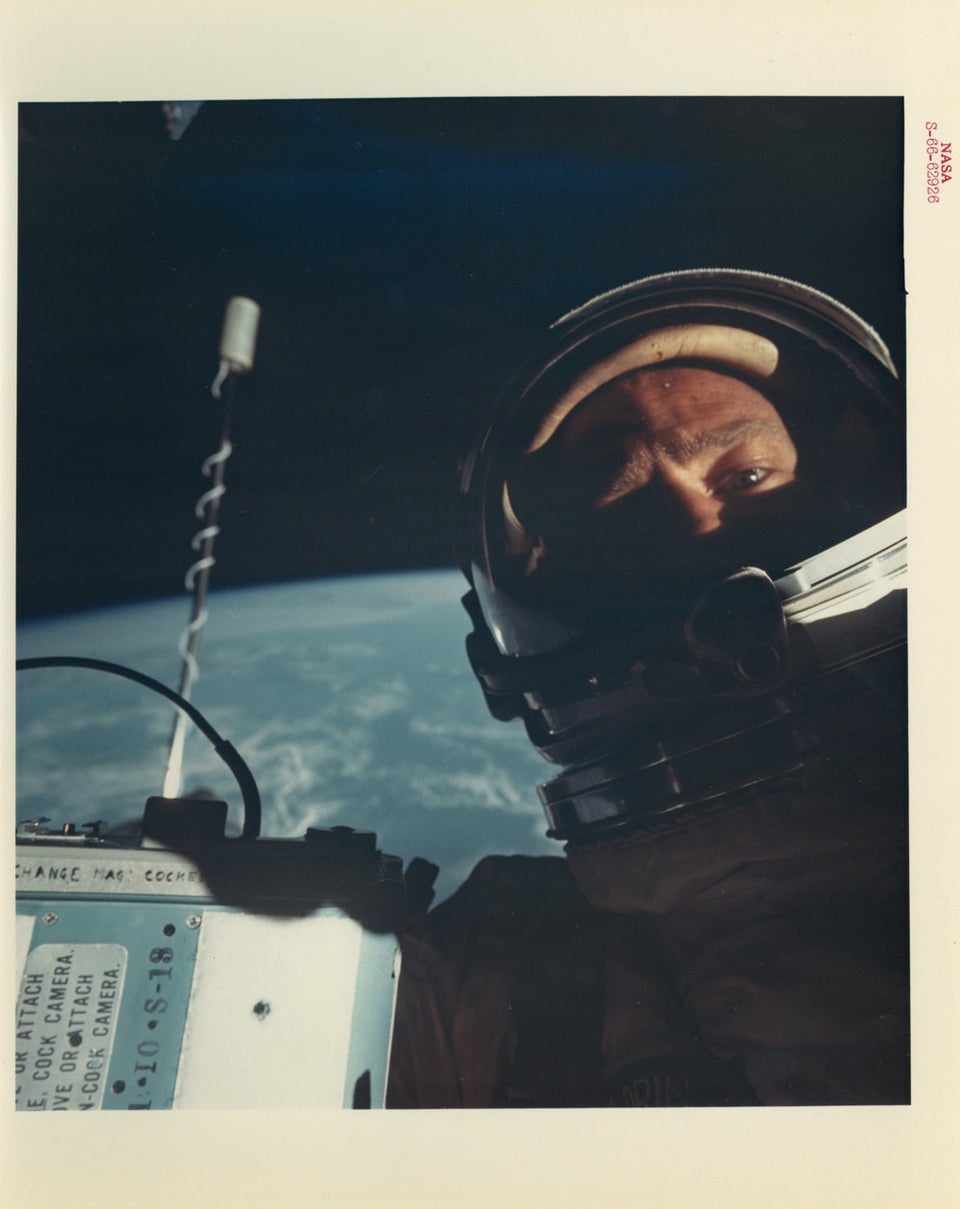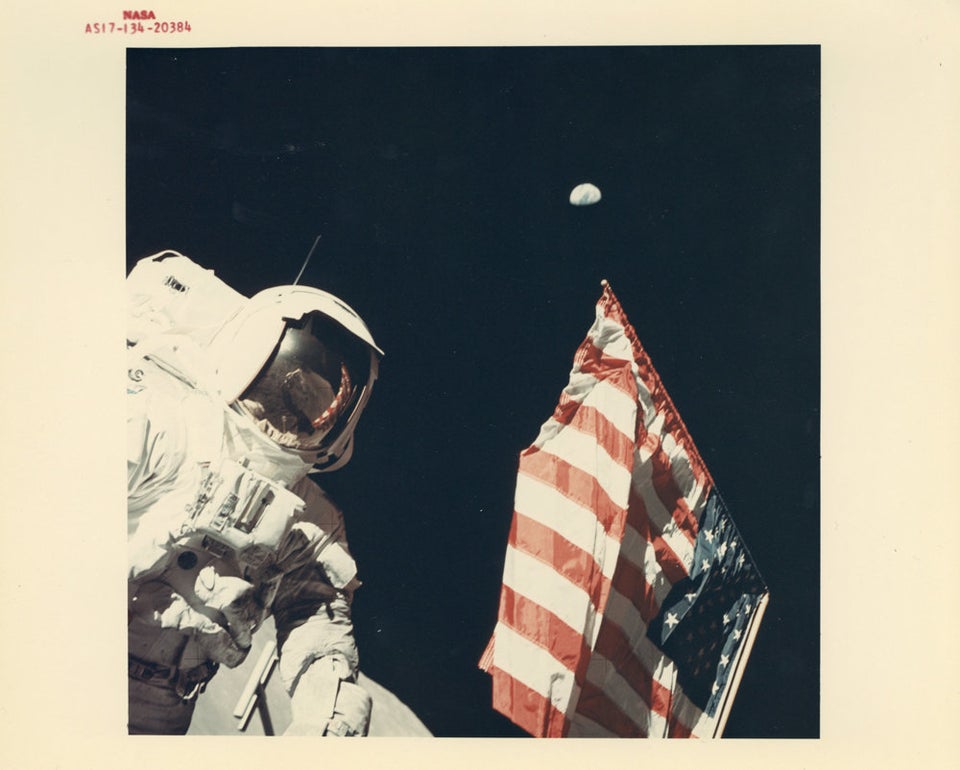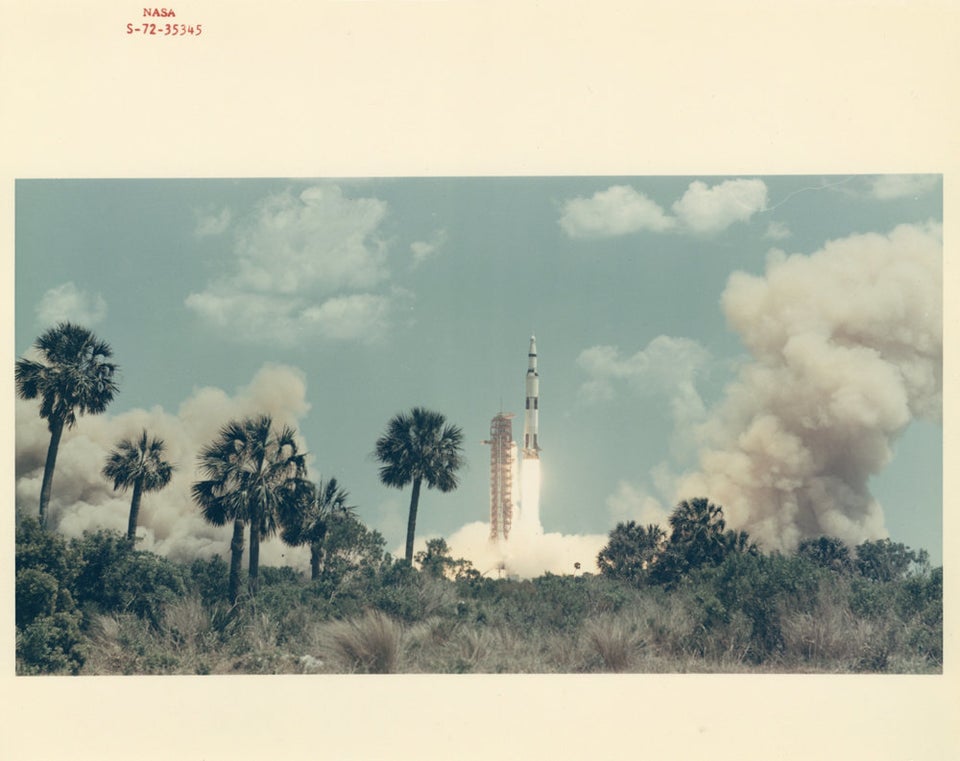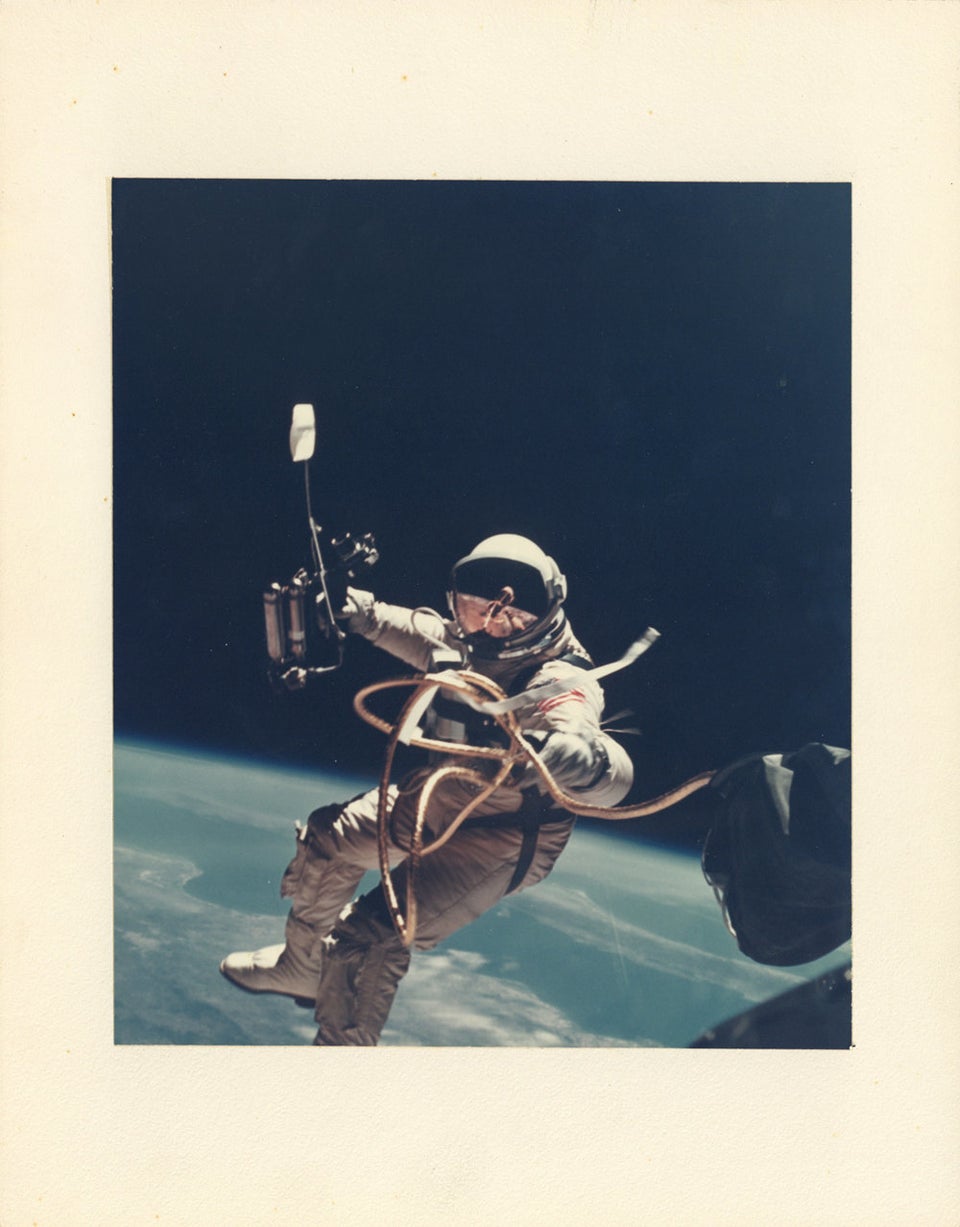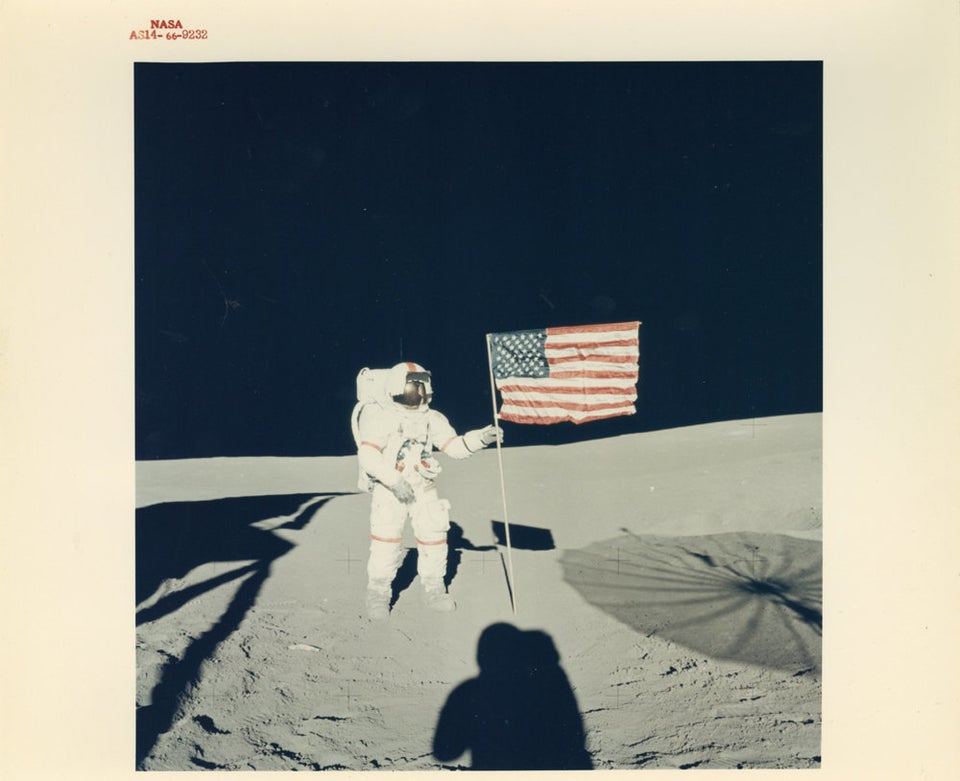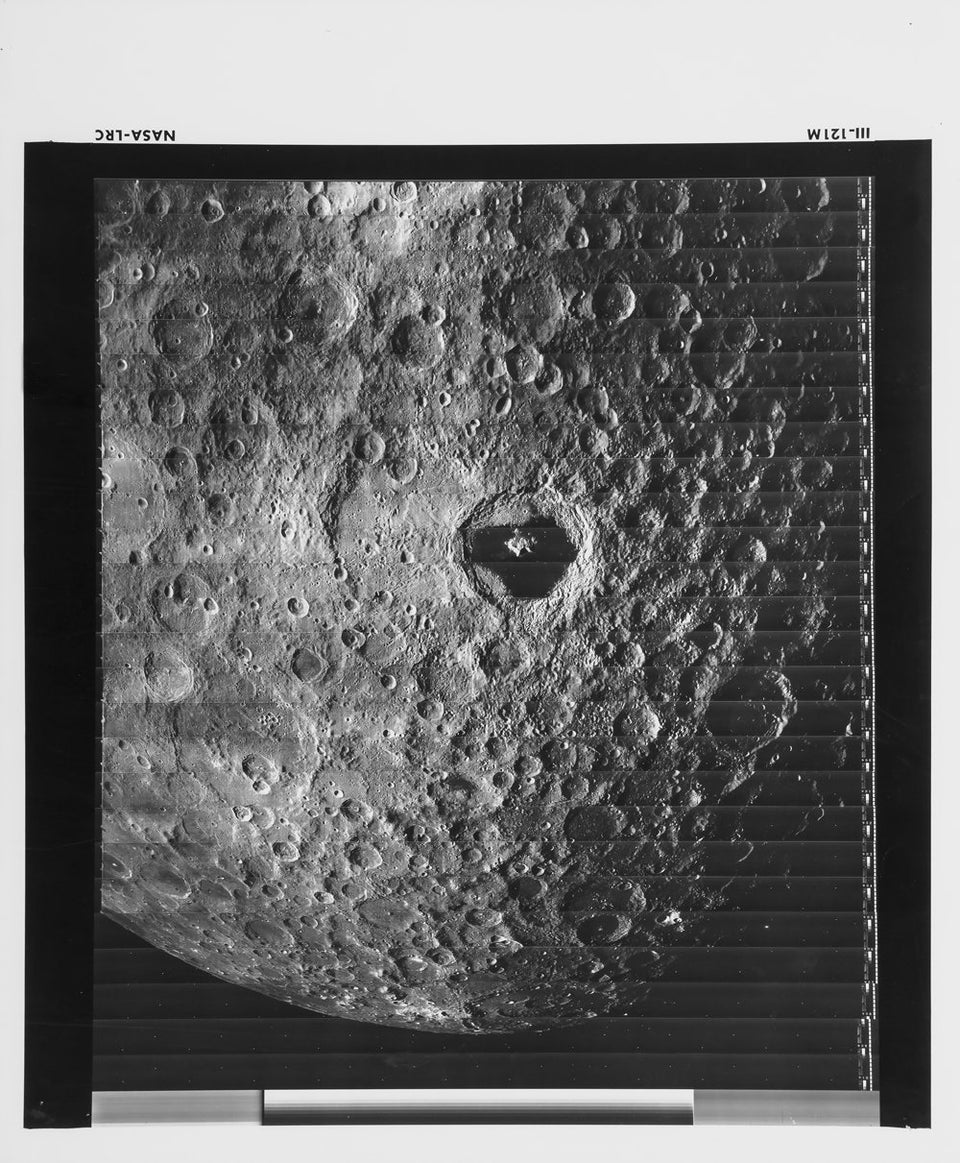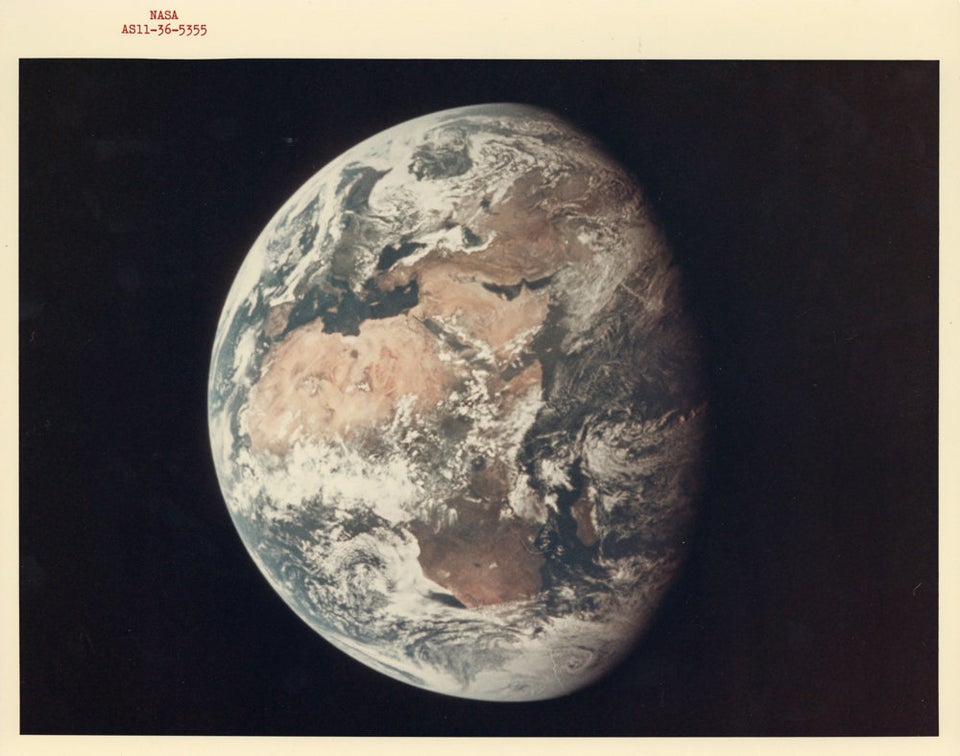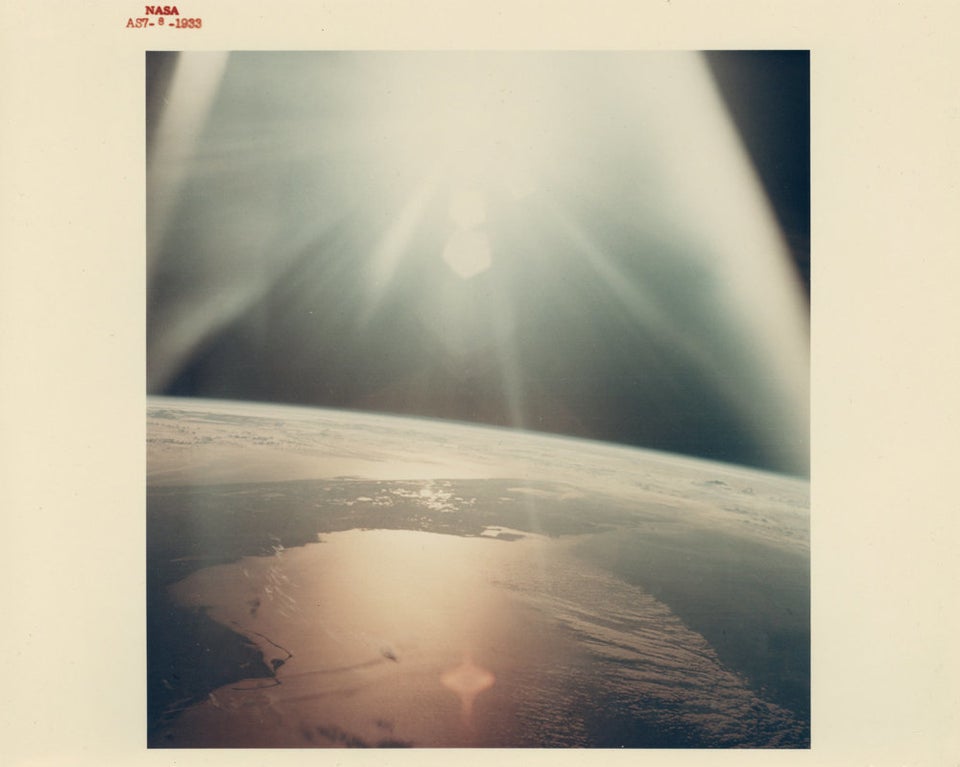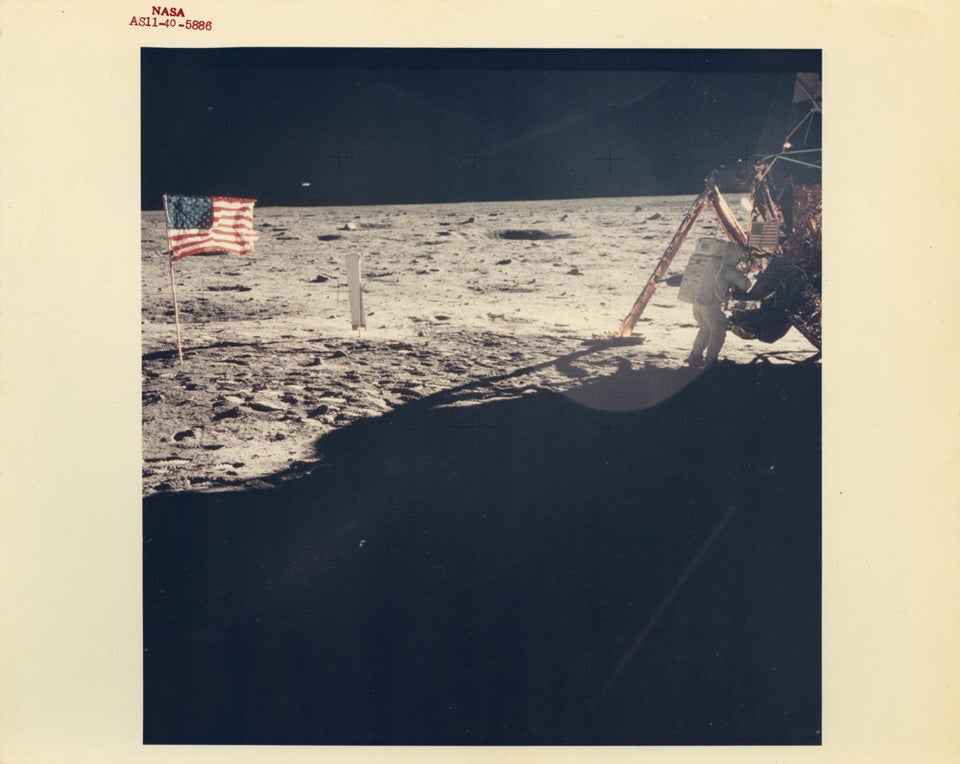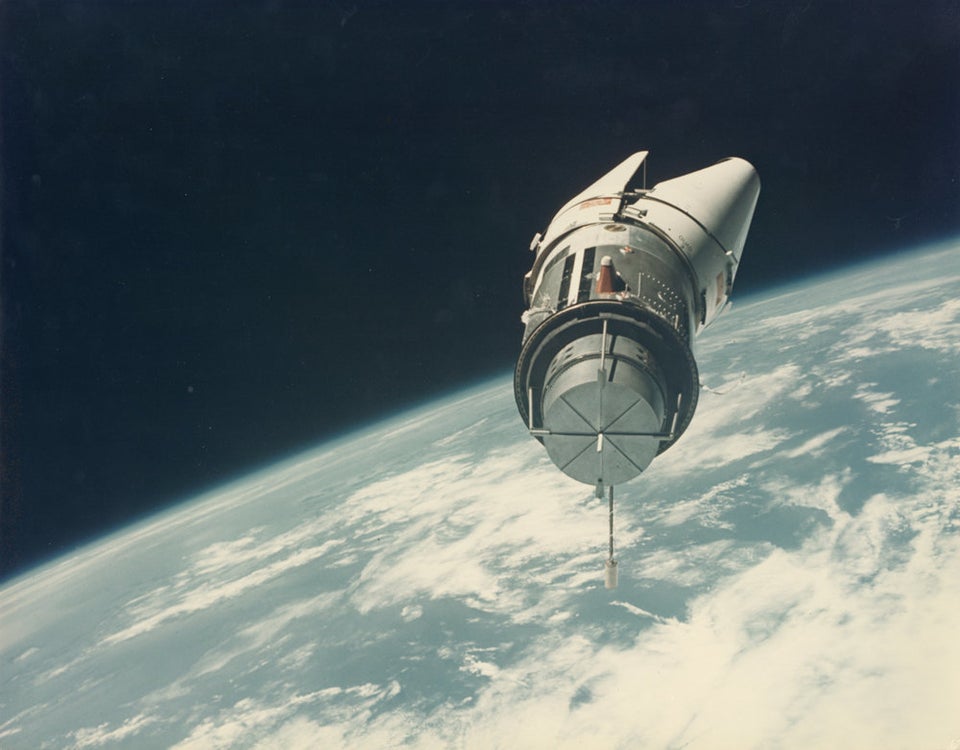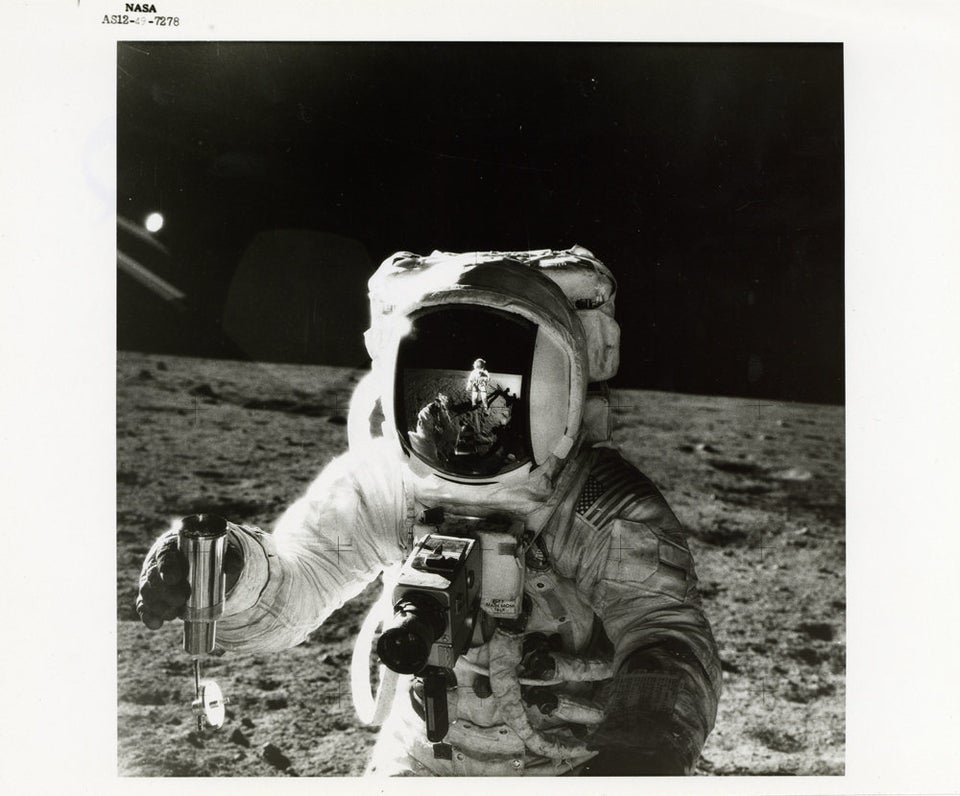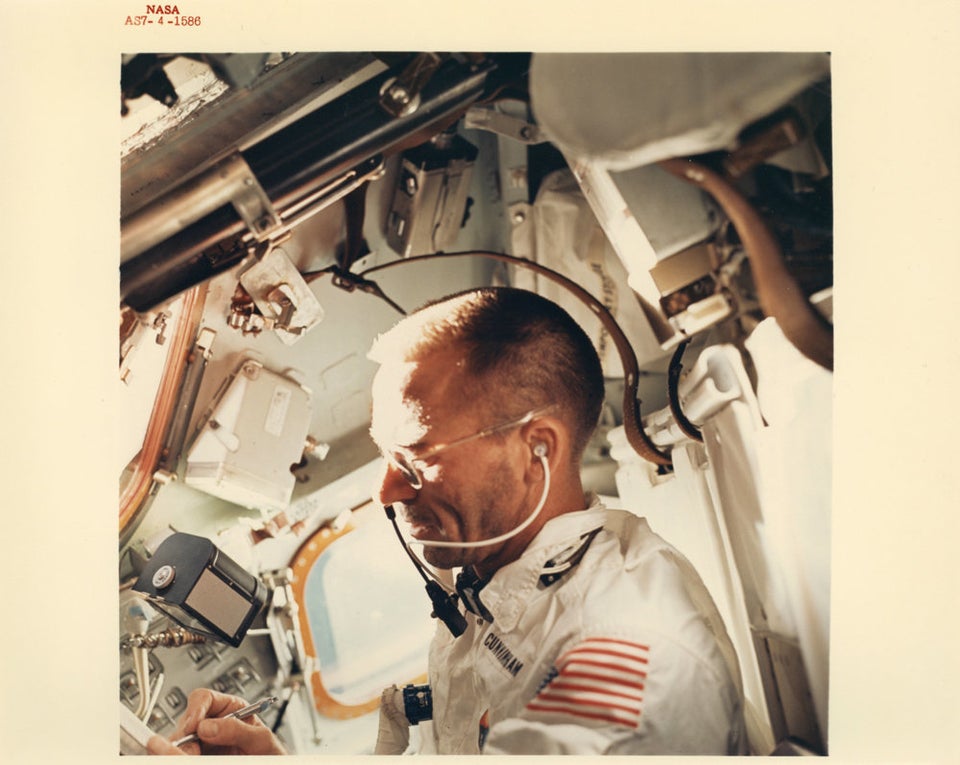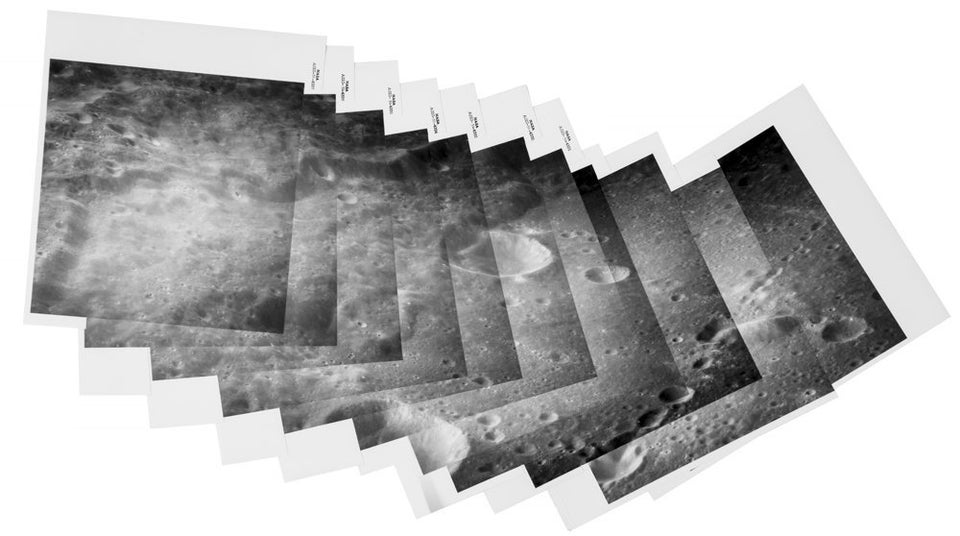On October 24, 1946, the world was introduced to the first photograph from space, a shot of our tiny planet taken 65 miles above Earth. The artist behind this iconic image was a V-2 rocket, programmed to capture a frame every 1.5 seconds before delivering a steel cassette of film back to the ground just minutes after it launched.
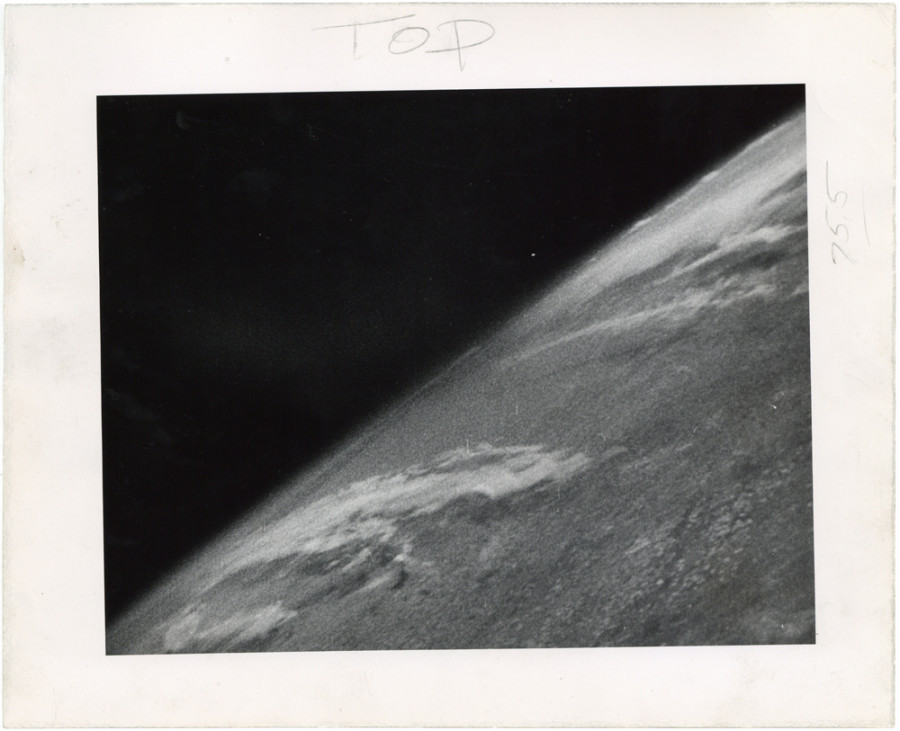
Clyde Holliday, The first photograph from space, October 24, 1946
This photograph is at the center of an auction this month, set to honor the storied tradition of celestial photography. Titled "From the Earth to the Moon: Vintage NASA Photographs of the First Voyages Beyond Our Home Planet," the auction (and corresponding exhibition at Mallett Antiques) will showcase 600 visual bits of space program history, everything from the first "selfie" in outer space, belonging to Buzz Aldrin, to an abstract portrait of an eclipse to panoramic views of lunar canyons.
One of the more memorable lots is a relic from 1969, the year Neil Armstrong first stepped foot on the moon. It wasn't until two decades after Armstrong became a lunar hero that NASA discovered a surprisingly clear image of him standing near a module, taken by his Apollo 11 colleague Aldrin and subsequently stashed in a Houston archive. Before that, NASA believed the only photos from the lunar surface were blurry shots grabbed by a TV camera and a 16 mm motion picture camera.
Beyond Aldrin's impressively composed image, the auction offers a number of works by astronauts-turned-artists. There's John Glenn, the first man to carry a camera into space. Eugene Cernan, the last man to trek to the moon. Ed White, the 1965 spacewalker who documented his time on Gemini 4 in 1965. As Sarah Wheeler, Head of Photographs at Bloomsbury Auctions describes the collection, these photographs reflect not only on the golden age of space travel, but the golden age of photography as well.
After all, the photographs on view are vintage Kodaks, printed shortly after they were taken, estimated to fetch anywhere between £300 to £10,000 ($462 to $15,390).
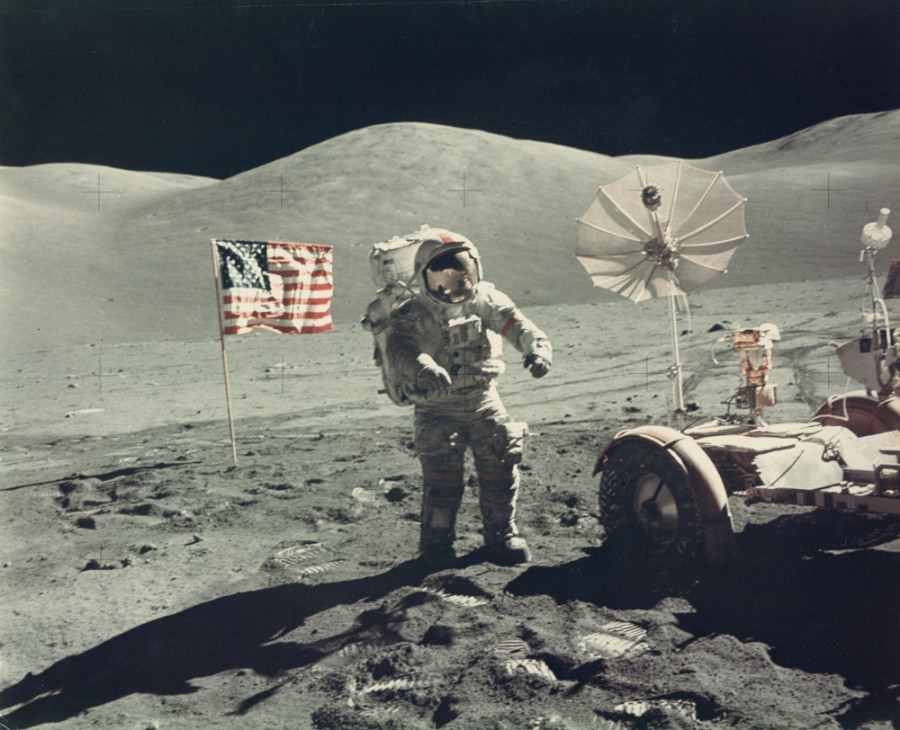
Harrison Schmitt, Portrait of astronaut Eugene Cernan, explorer of another world, Apollo 17, December 1972
“It’s incredible to realize that many photographs in this auction were unknown to the general public for decades until the complete NASA photographic archive began to appear digitally on the internet," Wheeler explained in a press statement. "This is particularly true of the collection of mosaics, real boots-on-the-ground panoramas taken by the Apollo astronauts as they explored the lunar landscape. These spectacular images were pieced together from individual Hasselblad frames for internal use by NASA scientists. We know of no such collection ever having been offered at auction.”
Check out a preview of "From the Earth to the Moon," on view at Mallett Antiques before the works head to auction on February 26 at Bloomsbury Auctions in London.
Buzz Aldrin, First self-portrait in space, Gemini 12, November 1966
Eugene Cernan, Harrison Schmitt with the Earth above the US flag, EVA 1, Apollo 17, December 1972
Liftoff, Apollo 16, April 1972
James McDivitt, First US Spacewalk, Ed White’s EVA over New Mexico, Gemini 4, June 3, 1965
Edgar Mitchell, Alan Shepard and the American flag, Apollo 14, February 1971
William Anders, First Earthrise seen by human eyes, Apollo 8, December 1968
First high quality photograph of the farside of the Moon
Walter Cunningham, Florida Peninsula looking East, Apollo 7, October 1968
Buzz Aldrin, The only clear photograph of Neil Armstrong on the Moon, Apollo 11, July 1969
Eugene Cernan, The angry alligator, Gemini 9, June 1966
Pete Conrad, Alan Bean with the reflection of the photographer in his visor, EVA 2, Apollo 12, November 1969
Walter Schirra, On-board portrait of astronaut Walter Cunningham, Apollo 7, October 1968
James Irwin, Panoramic view of David Scott photographing a geologic find, 300 feet up the flank of 11,500-foot-high Hadley Delta mountain, Station 6, EVA 2, Apollo 15, August 1971
James Irwin, Panoramic view of David Scott photographing a geologic find, 300 feet up the flank of 11,500-foot-high Hadley Delta mountain, Station 6, EVA 2, Apollo 15, August 1971
Panoramic view with David Scott at the ALSEP site near the LM, Station 8, EVA-2
Al Worden, Oblique telephoto panorama of the North Rim of Crater Pasteur on the farside of the Moon, Revolution 37, Apollo 15, August 1971
Telephoto panorama of the floor and western rim of MendeleevBasin, Apollo 10, May 1969
Support HuffPost
Our 2024 Coverage Needs You
Your Loyalty Means The World To Us
At HuffPost, we believe that everyone needs high-quality journalism, but we understand that not everyone can afford to pay for expensive news subscriptions. That is why we are committed to providing deeply reported, carefully fact-checked news that is freely accessible to everyone.
Whether you come to HuffPost for updates on the 2024 presidential race, hard-hitting investigations into critical issues facing our country today, or trending stories that make you laugh, we appreciate you. The truth is, news costs money to produce, and we are proud that we have never put our stories behind an expensive paywall.
Would you join us to help keep our stories free for all? Your contribution of as little as $2 will go a long way.
Can't afford to donate? Support HuffPost by creating a free account and log in while you read.
As Americans head to the polls in 2024, the very future of our country is at stake. At HuffPost, we believe that a free press is critical to creating well-informed voters. That's why our journalism is free for everyone, even though other newsrooms retreat behind expensive paywalls.
Our journalists will continue to cover the twists and turns during this historic presidential election. With your help, we'll bring you hard-hitting investigations, well-researched analysis and timely takes you can't find elsewhere. Reporting in this current political climate is a responsibility we do not take lightly, and we thank you for your support.
Contribute as little as $2 to keep our news free for all.
Can't afford to donate? Support HuffPost by creating a free account and log in while you read.
Dear HuffPost Reader
Thank you for your past contribution to HuffPost. We are sincerely grateful for readers like you who help us ensure that we can keep our journalism free for everyone.
The stakes are high this year, and our 2024 coverage could use continued support. Would you consider becoming a regular HuffPost contributor?
Dear HuffPost Reader
Thank you for your past contribution to HuffPost. We are sincerely grateful for readers like you who help us ensure that we can keep our journalism free for everyone.
The stakes are high this year, and our 2024 coverage could use continued support. If circumstances have changed since you last contributed, we hope you’ll consider contributing to HuffPost once more.
Already contributed? Log in to hide these messages.


